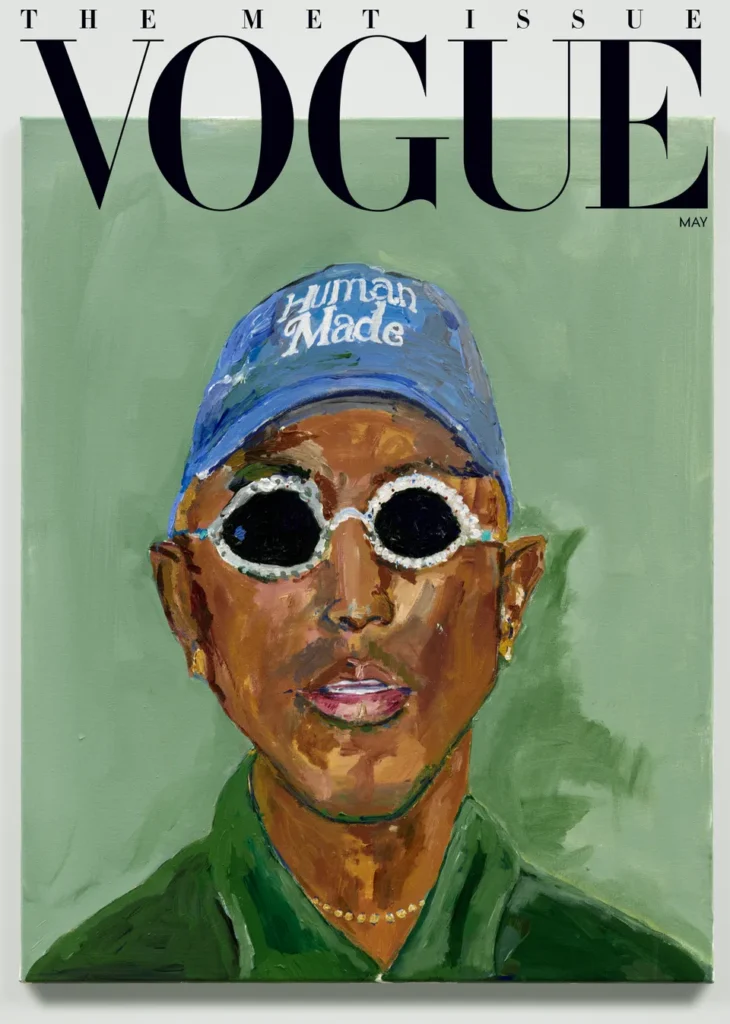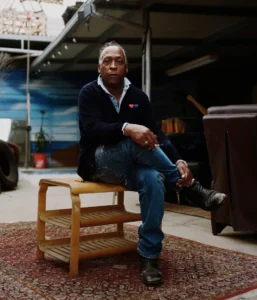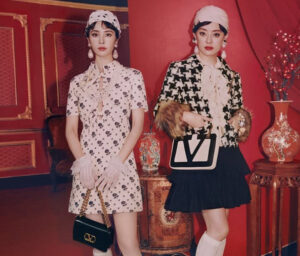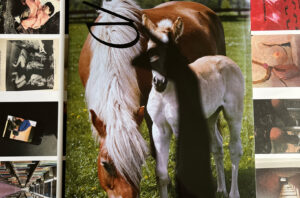In a media ecosystem increasingly dominated by hyper-polished photography and AI-generated perfection, Vogue’s decision to put a painting on the cover of its May issue speaks volumes. More than a stylistic departure, it feels like a reclamation—of texture, of labor, of human subjectivity. And the artist they chose to do it—Henry Taylor, the Los Angeles-based painter whose portraits exist at the edge of realism and reverie—only reinforces the moment’s depth.
The subject? Pharrell Williams—musician, polymath, and now the artistic director of Louis Vuitton men’s. A man whose influence in fashion rivals his legacy in sound. A figure who, like Taylor, channels Black cultural memory through multidimensional expression. Their paths first crossed in Paris, at Pharrell’s debut LV show two years ago, where the designer had stitched miniature Henry Taylor portraits into the fabric of his suits. Now, in a poetic turn, it is Taylor who renders Pharrell—not in pixels or pixels-per-inch, but in strokes of color and human perspective.
The Artist’s Gaze: Henry Taylor and the Language of Portraiture
To understand why this cover matters, one must first understand Henry Taylor’s place in the contemporary art canon. Taylor doesn’t paint for flattery. He paints to witness—to hold a person’s presence in pigment, even if that presence is blurred, refracted, or abstracted. Born in 1958, Taylor emerged from Southern California’s vibrant artistic terrain with a commitment to capturing Black life not as spectacle, but as lived nuance.
His portraits range from famous figures to strangers encountered on the street. They’re as likely to feature a homeless man in downtown L.A. as they are a rap legend or civil rights hero. But all are treated with dignity and immediacy, often set against flatly painted backgrounds or collapsing spatial logic that directs the viewer’s attention inward.
Taylor’s brushwork is instinctive, almost impulsive. There’s no artifice, no calculated polish. His figures feel mid-thought, mid-motion, caught in a moment of revelation—or at least reflection. He once said, “I paint what I see, but more importantly, I paint what I feel about what I see.” That emotional undercurrent is what makes his work transcend the canvas. It doesn’t just represent—it translates.
So when Vogue asked Taylor to paint Pharrell, it wasn’t a commission of convenience. It was a gesture of cultural alignment, a portrait rooted in mutual admiration and creative symmetry.
Pharrell and Taylor: Mutual Admiration, Mutual Icons
Their admiration is mutual and layered. Pharrell, ever attuned to the visual realm, had long held Taylor’s work in reverence. At his first Louis Vuitton menswear presentation in June 2023, Pharrell embroidered miniature Taylor portraits onto tailored garments—treating the painter’s work not just as inspiration, but as textile theology. Taylor’s renderings were sewn into the seams of luxury, embedded into a heritage house long criticized for its eurocentric rigidity. In doing so, Pharrell positioned Taylor’s imagery as living iconography—worn, not just exhibited.
Taylor, for his part, understood what Pharrell was doing. He saw not just homage, but contextual liberation—Black art placed at the heart of a European institution, not as exoticism, but as authority. In this light, the Vogue cover is not their first collaboration. It’s a continuation of a dialogue between two artists who refuse to be confined by medium or institution.
Painting Without a Sitting: The Portrait as Memory
What makes this cover all the more extraordinary is the fact that Taylor painted it without a formal portrait sitting. There were no hours of stillness, no studio lighting, no cross-legged silence as artist studied subject. Taylor painted Pharrell from memory—based on their brief meeting in Paris, on his knowledge of Pharrell’s style, and on the ineffable energy he’d once felt standing beside him.
This is signature Taylor. His portraits often emerge from loose sketches or mental images, not rigorous anatomical studies. He works from impression, not precision—from vibe, not vanity. His rendering of Pharrell on the Vogue cover is thus less about exact likeness and more about presence. It’s Pharrell as energy. As posture. As possibility.
The painting itself is rich with character. Pharrell is seated, a leg stretched out—casual but composed, draped in layered clothing that alludes to his fashion prowess without overwhelming the composition. His gaze is neutral yet searching, not quite confrontational, not quite serene. The palette is muted but alive. There’s a leg up, yes—but also a world behind those eyes.
Taylor has said of the portrait, “What we need today is more humanity and less insanity.” That ethos bleeds into every brushstroke. It’s not Pharrell-as-celebrity. It’s Pharrell-as-man—thinking, dressing, creating, becoming.
Vogue’s Outlook
This marks the fifth time in eight years that Vogue has run a painting on its cover—a rare deviation from the high-gloss tradition of fashion photography. Past artist covers have included works by John Currin, Kerry James Marshall, and Jordan Casteel. Each time, the move has signaled something deliberate—an editorial choice to slow the frame, to let viewers sit with an image that isn’t instantly legible.
In an era of algorithm-fed visuals, a painting demands pause. It doesn’t flicker or swipe. It doesn’t load. It exists. The Taylor portrait does this with extraordinary poise. It breaks from the mechanical pacing of trend cycles and reminds the reader that style is a story, and portraiture remains one of its oldest and most sacred forms.
Louis Vuitton, Legacy, and the Black Artistic Vanguard
Pharrell’s ongoing role at Louis Vuitton is also inextricably tied to this moment. Since his appointment as artistic director of menswear, Pharrell has brought a sensibility to Vuitton that is less about hype and more about cultural anchoring. His shows—set on the Pont Neuf, featuring gospel choirs and guest appearances by icons like Jay-Z—aren’t just fashion events. They are diasporic declarations.
By threading Taylor’s work into his first LV collection and now becoming the subject of a Taylor painting himself, Pharrell constructs a loop of reverence: a Black designer, rendering homage to a Black painter, who now returns the gesture in a major fashion publication. This kind of mutual elevation is what legacy looks like when it’s built within the community—not bestowed by external validation, but constructed through shared vision.
Taylor, in turn, becomes not just a painter of the moment, but a painter of the movement—a chronicler of Black presence in high fashion, fine art, and mainstream editorial space.
Reclaiming the Gaze
There’s something particularly powerful about a Black man painting another Black man for the cover of Vogue. Historically, portraiture was a domain reserved for European aristocracy, and when extended to Black subjects, often filtered through the eyes of outsiders. But here, in this image, we see representation without translation. We see one artist seeing another—not for his celebrity or status, but for his humanity.
This is how the gaze is reclaimed. Not with spectacle, but with sincerity.
Taylor’s painting reminds us that art still matters—not because it trends, but because it holds. It holds memory. It holds presence. And it holds power.
No comments yet.









